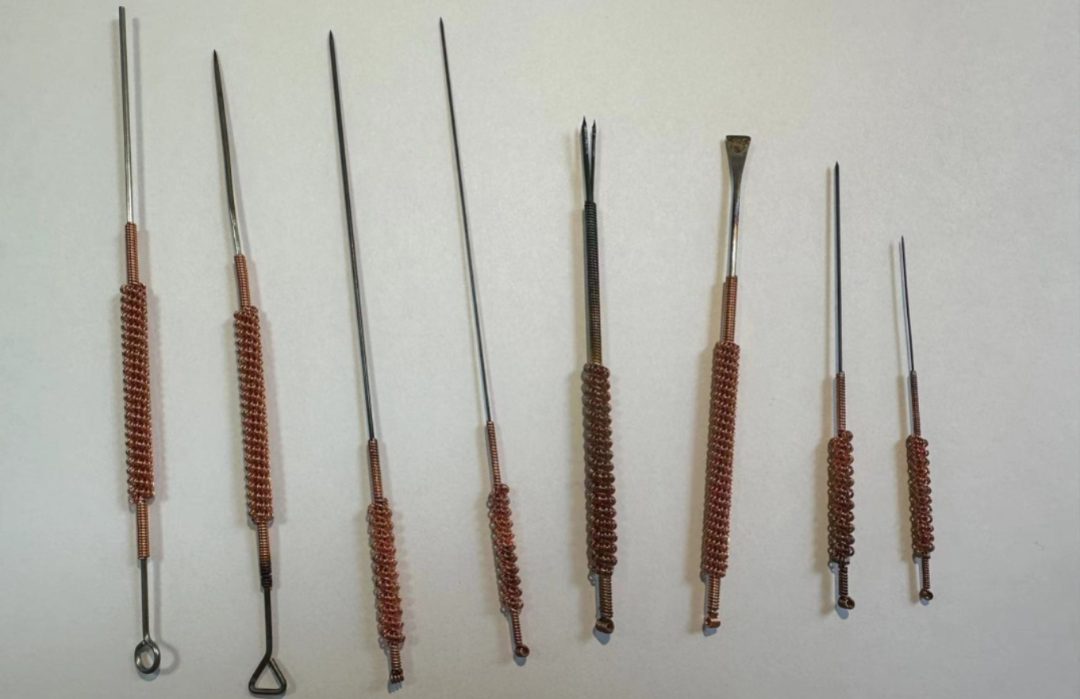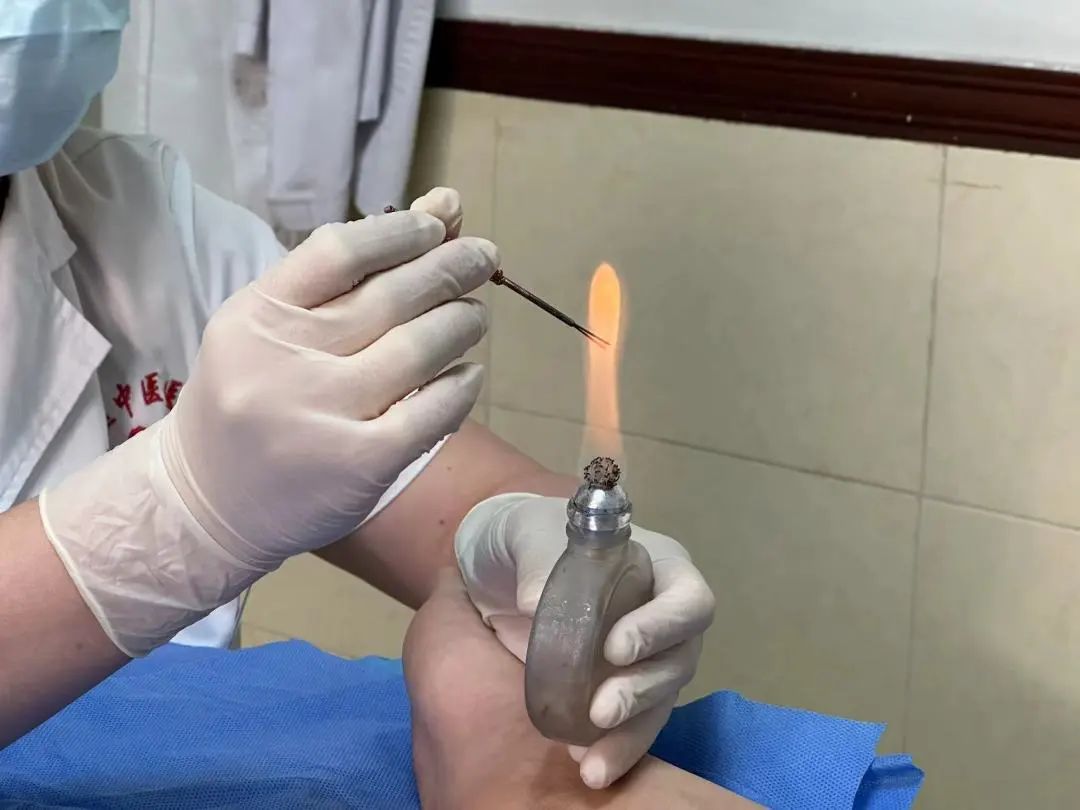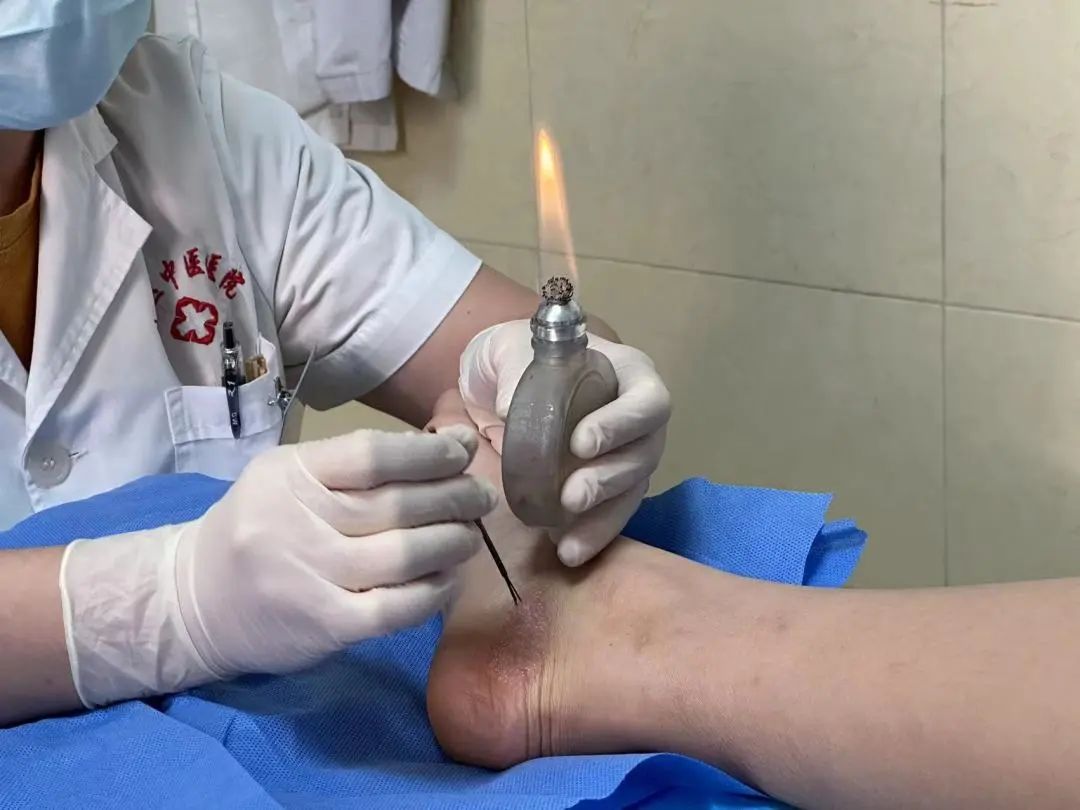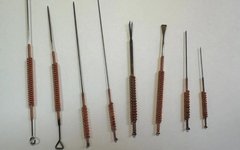Rehabilitation Department’s Unique TCM Rehabilitation Techniques Fire Needle Therapy  TCM Suitable Techniques
TCM Suitable Techniques
Fire needle therapy involves heating the needle tip until it is red hot and then using it to prick specific acupuncture points (腧穴, shùxué) or local lesions, thereby achieving the purpose of disease prevention and treatment. In ancient times, it was referred to as “burning needle” (燔针, fánzhēn) or “quenching needle” (焠刺, cuàncì).
Fire Needle Instruments


The fire needle, as a special technique in acupuncture, has the effects of warming the meridians (经络, jīngluò), supporting the body’s yang energy (阳气, yángqì), and expelling pathogenic heat (邪热, xié rè). Clinically, it can be used alone or in combination with other acupuncture techniques.
The modern fire needles are typically made of stainless steel, measuring 3-4 inches in length, with a thick, round, sharp tip, and the handle is made of tungsten alloy wire. They are characterized by high-temperature resistance, minimal deformation, and strong hardness at high temperatures.
Coarse fire needles are commonly used for draining pus and reducing swelling, suitable for cysts and nodules, but not for the face or areas with thin muscles; medium coarse fire needles have a wide range of applications, except for the face and weak muscle areas, while fine fire needles are mainly used for the face and other weak muscle areas, as well as for the elderly, children, and those with weak constitutions. Flat-headed fire needles are often used for age spots (老年斑, lǎonián bān), flat warts (扁平疣, biǎnpíng yóu), etc.; multi-headed fire needles are primarily used for larger skin lesions that are not on the face, such as herpes zoster (带状疱疹, dàizhuàng pàozhěn) and postherpetic neuralgia (带状疱疹后遗神经痛, dàizhuàng pàozhěn hòuyí shénjīng tòng), psoriasis (银屑病, yínxièbìng), chronic eczema (慢性湿疹, mànxìng shīzhěn), and pruritus (皮肤瘙痒症, pífū shàoyǎng zhèng). Fine fire needles can be used on various body parts, including acupuncture points, and have good effects on facial paralysis (面瘫, miàntān) and trigeminal neuralgia (三叉神经痛, sānchā shénjīng tòng).
Mechanism of Fire Needle Therapy


Fire needle therapy combines the stimulating effects of acupuncture on the meridian energy (经气, jīngqì) with the warming effects of moxibustion (艾灸, àijiǔ) to dispel cold. Clinically, it often yields remarkable results with less effort. The mechanisms of action include: harmonizing yin and yang (阴阳, yīnyáng), supporting the righteous qi (扶正, fúzhèng) and expelling evil (祛邪, qūxié), warming the meridians, opening the pathways to expel pathogens, using heat to draw out heat, and the warming moxibustion effect. Experimental studies have shown that fire needles can enhance the phagocytic ability of white blood cells in experimental animals, promote the reabsorption and repair of diseased tissues; the thermal stimulation from fire needles can dilate local blood vessels, increase vascular permeability, and regulate inflammatory factors in the body. Therefore, it is commonly used for treating neck and shoulder pain, arthritis (关节炎, guānjié yán), as well as common and difficult-to-treat diseases such as herpes zoster, eczema, vitiligo (白癜风, báidiànfēng), and psoriasis.
Indications for Fire Needle Therapy


1. Fire needle therapy for myofascial pain syndrome (肌筋膜炎, jī jīn mó fā yán). Fire needles directly introduce heat into the body through the acupoints, stimulating the meridian energy and invigorating blood circulation, thereby warming and strengthening the yang energy of the organs. Simultaneously, by cauterizing the acupoints, it opens the pathways of the meridians, allowing the expulsion of pathogenic factors such as wind, cold, dampness, and toxins through the needle holes, achieving a dual effect of supporting the righteous and expelling the evil.
2. Fire needle therapy for sprains. The main clinical manifestations of sprains are pain and functional impairment at the affected site, often caused by sudden injuries that damage the meridians, leading to qi stagnation and blood stasis. Fire needles can warm the meridians, promote qi and blood circulation, thus alleviating pain and resolving stasis.
3. Fire needle therapy for tennis elbow (网球肘, wǎngqiú zhǒu) and shoulder periarthritis (肩周炎, jiānzhōuyán). The aim of fire needle therapy is to enhance the local qi and blood circulation through external heat, disperse accumulations, and unblock the meridians to achieve therapeutic goals.
4. In dermatology: Common skin conditions treated include postherpetic neuralgia, pustular and cystic acne, flat warts, chronic pruritic skin conditions.
5. In internal medicine: Conditions such as insomnia, dizziness, post-stroke sequelae, chronic gastroenteritis, bronchitis, and common gynecological issues like cold uterus (宫寒, gōng hán), dysmenorrhea (痛经, tòngjīng), and scanty menstruation.
END
 Source: Huangpu District Traditional Chinese Medicine Hospital
Source: Huangpu District Traditional Chinese Medicine Hospital

